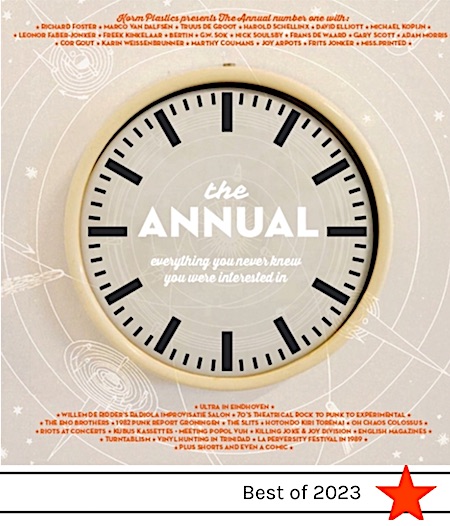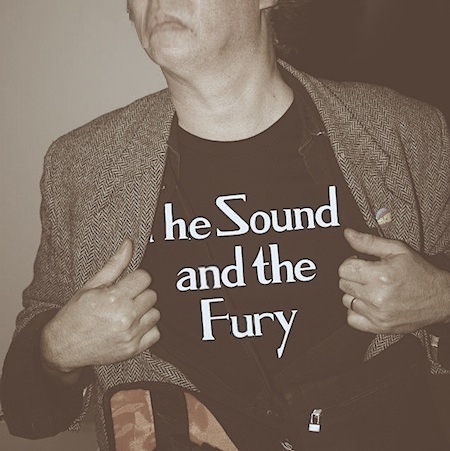
To keep up to date on the ookoi's b.ookoi's progress and receive information on related events and activities: follow Stduio on Bandcamp!

[ b.ookoi (i) | (ii) | 019 | 131 | 138 | 178 | 284 | 329 | 419 | 506 | 507 | 562 | 624 | 664 | 789 | 793 | 954 | b.ookoipera]
23 min read 🤓
A Year in Rear, Stduio's 2023
[ d.ookoi writes b.ookoi (ii) ]
december 31, 2023
« Tout au monde existe pour aboutir dans un livre »
(Stéphane Mallarmé)
[ about | unbearable | annual | anger | unpublic | to do: 1024 ]
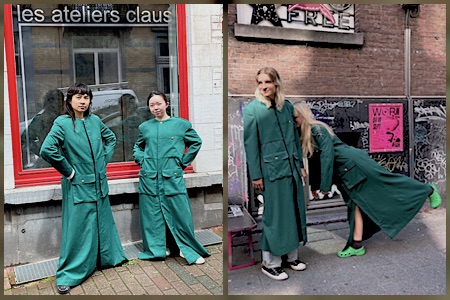
...
« Het opmerkelijkst was de man die kunstig levende vliegen van de muur hapte » (Not really a surprise, to find nookoi at major festivals in Europe this fall. It has become sort of a tradition.)
...
When envisioning someone 'looking back,' I picture them standing amidst a stony path on a moody hill, and making a full one-hundred-and-eighty-degree turn to gaze toward the path they've traversed (ominous clouds, a hint of rain, a sense perhaps of distant thunder).
It differs from a mere rear-view. A rear-view is no 'looking back'; it prompts reflection on what lies behind while moving forward. There's no standing still, no turning around—it's a continuous journey forward with the past in contemplation.
This here rear-view is the second in a series of evolving, unfinished, tentative writings that follows the ookoi's progress in the writing of their b.ookoi. Like the first one of these writings, and the ones still to follow, it is also about what b.ookoi is about, about the ways and hows in which it structured, and about the paths along which it is about to go.
Prompt: "Two ultramodern speculative musicians dressed in green monk robes together ride a two-seat Harley Davidson motorcycle. We see their backs. The large rear-view mirror on the side of the steering wheel reveals the track that lays behind them, while we peek into a far ahead distance, along the long and winding road that is the duo's path."
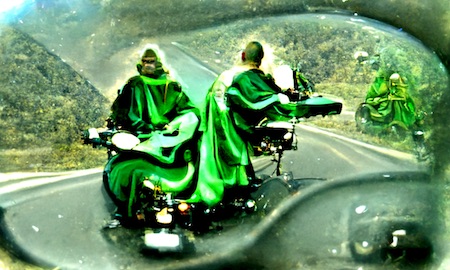
about
So, these are meta-writings. Some of it might eventually find a place somewhere within the b.ookoi's 1024 slots. These pages are meant to feed the interest and keep the attention of you that are interested, and then spark the interest of a few, even more than a few, more. We of course depend and count on you to spread the word. For you are right to be interested. The b.ookoi is a document unlike any other. Never mind what your Facebook friends, Thread-er-s, Whatsapps or the newspapers say.
Go and draw it on the walls!

Its power lies in what maybe is omitted as much as in what is said. It adds up to a unique kaleidoscopic picture of decades of cutting-edge art making. Which, curiously, has always kept us in the margins. Not by choice. But, yes, by fact. Not as chosen-to-be-outsider-artists. But still, there we were, for decades on end: always on the outside looking in.
But, well, « ce sont les marges qui tiennent la page », to recall words of French nouvelle vague film-director Jean-Luc Godard (1930-2022). And while leafing through the September/October edition (#225) of the Flemish art magazine 'De Witte Raaf'( * ) I came upon this phrase, from Belgian critic and theoretician Bart Verschaffel: "an artwork does not come with a meaning; it acquires meaning when someone chooses to focus and dwell on it, [...] add world to it." But on the other hand, he writes in the same essay ( ** ), "Criticism [...] inevitably does violence to the work, and rightly so, because the artwork is full of tricks and cannot be trusted."
So true! If there is anything we can not, be trusted it is.
unbearable and other writings
Dear readers & other lovers of words! Two more than decent, nay, brilliant!, texts on the ookoi's art were published in our outer world this year, 2023. The first was published in eContact! the online journal for electroacoustic practices of the Canadian Electroacoustic Community (CEC). Titled: Towards an Unhearable Music. Conceptualism in the ookoi's art, it appeared in edition 21.2 of the e-magazine, an edition dedicated to 'Conceptual Approaches to Sound-Based Artistic Practices', available online as of the autumn of 2023.
Before this official online publication, a somewhat earlier version of the text was published in the form of a small booklet in an even smaller edition, 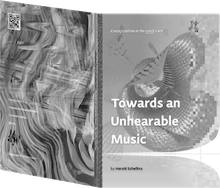 that meanwhile is (more or less or no longer) available, and entered the misty (because of all the wie-rook) realm of if-only-I-had-collectors' items.
that meanwhile is (more or less or no longer) available, and entered the misty (because of all the wie-rook) realm of if-only-I-had-collectors' items.
In all of its petite-ness, the paper booklet did make for our biggest social media success to date, when our former Vinyl & Gonzo colleague, Paradiso punk specialist and dj-journalist Oscar Smit reported on our late 2022 few hours rainy stay on the Amsterdam Spui book market, where the number of sellers far exceeded the number of sales, as focused on the release of 'Towards an Unbearable Music'. That, obviously Freudian, slip of course makes for a far better title, that we happily reserve for some upcoming writing.
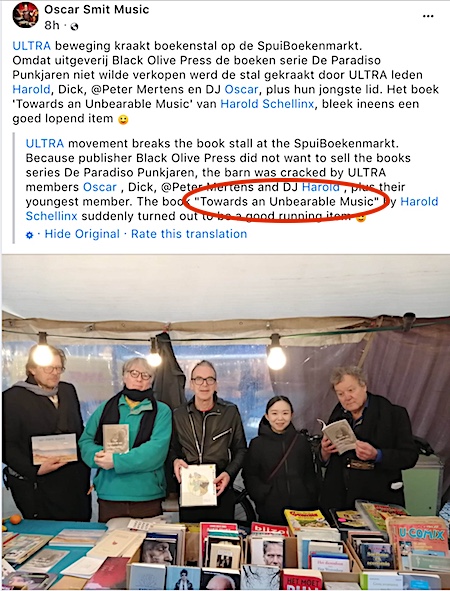
The second publication concentrating on the ookoi's proceedings and their Long March on to the future, appeared in the first edition of an annual magazine-to-(may)-be, quite appropriately called The Annual, and published by the Dutch Korm Plastics, an independent undertaking run by two veterans of the Dutch alternative, DIY music, art, design etc scene, Frans de Waard and Alfred Boland, who was responsible for the stunning design. The magazine is a jewel for the eye, and for that reason alone, well worth the few euros that one needs to spend in order to own a paper copy.
Given The Annual's context and cradle, it of course does not come as a surprise that the bulk of its content leads us back to days long gone, with stories related to the punk / post-punk music scenes of the 1980s, both national (Dutch) and international.
Richard Forster—music lover, curator, programmer, prolific author of fiction and faction, of british birth, but renowned and academically approved specialist on the history of Dutch post-punk—contributes an in-depth study on institutions, people, happenings, politics and sociology in the Dutch city of Eindhoven (Philips-town) during the days of ULTRA and post-punk.
Marco van Dalfsen wrote a fine article starring Dutch artistic free-thinker, anarchist and Fluxus star Willem de Ridder (1939-2022), a major inspiration (not only but surely also via the Radiola Improvisation Salon, alive and kicking in the years 1978 to 1984, which is the article's focus) for a generation of young sound-squires, quite some of which aspired to become chevaliers, and sent De Ridder their audio concoctions on cassette tapes, ranging from nothing more than a fist full of smelly audible frequency farts, to intricately crafted sound tapestries. Together it made for sort of a sonic Pandora's box, that the intrepid rid-der (as in 'someone who gets rid of things') opened up, so that all of it might wave on, diffuse out there, spread through the Dutch ether and from there on to the stars. Van Dalfsen got hold of boxes full of the original cassettes that decades ago were sent to De Ridder. Among these there was a tape submitted to Radiola by FPCM, in October 1981. On that K7 Peter had recorded in his characteristic eloquent Dutch diction the letter that accompanied the submission. Being the beginning of the tape, this may very well have been the part that De Ridder subsequently FM-projected into the ether and the universe, as he most of the times just opened up the envelopes live on air and then plugged in and played the things, for a minute or so, regardlessly. That was the magic.
Here is an English translation of FPCM's words:
Dear Willem de Ridder,
a playable cassette especially for you.
These are ten improvised loops, in fact they can run for hours, but in this case 30 seconds each so a total of exactly 5 minutes. I call them listening games. Although it's not important how they were made, [maybe good to know that I used] as little as possible [real] instruments to show that anyone can do it.
...
If any of these pieces catches your ear, feel free to cut, paste, and enjoy them for a 15-minute spin. Your support keeps me creative, off the streets and out of pubs.
You can hear FPCM's Brief aan Willem De Ridder, complete and unabridged, on one of the 'Awesome Foursomes' that Stduio put out in 2023.
It's on No. 461, released on the 6th of October 2023.
But of course there's more in the The Annual.
More and more and more...
Dutch queen of ULTRA Truus de Groot describes her early Werdegang, accompanied by a great many black-and-white photographs from back-in-those-days;
it's 1985 when David Elliott brings his brother Patrick along for a drink in the pub with Brian Eno and his brother Roger;
Michael Kopijn instructs us on late 1970s punk fanzines in the city of Groningen;
fab Leonor Faber-Jonker, who, after many, many years of no-see, I had the pleasure meeting no less than three times this year (in Rotterdam during the Studio Worm residency, performing with Hollands Spoor at the HOK-gallery in The Hague, and last but not least at the 9 December Gonzo get-together-party in Antwerp) convincingly shows that still, and maybe now more than ever, girls, women and the world need the anger, dare and power of Slits;
there's a murder mystery and weird jazz in an uptown Tokyo bar, recounted by Freek Kinkelaar, who also contributes a number of fun columns on vinyl curiosities, as does Frits Jonker ;
a cartoon by Bertin;
the 'god-awful' rattling-on-the-pavement sounds made by suitcase wheels that are irritating ex-Ex's G.W. Sok;
the fury of crowds analysed and put into perspective by Nick Coulsby;
the comprehensive story of the Dutch K7-label Kubus Kassettes reflected, told to and by Frans De Waard ...
...
Still only half way yet...
...
Texts about Florian Fricke, the man behind German Kraut outfit Popul Vuh, and its Werner Herzog-liaison (Gary Scott, Dolf Mulder);
Unknown Stories about and around Joy Division, Killing Joke and Motörhead, penned down by Adam Morris;
followed by a largely unintelligible (at least for me it was) rant on 1980s pop/rock journalism by Cor Gout, which hit me as sort of a Dada-like poem; but as said, that's probably just me, ha ha ...
There is an interesting though not fully convincing read on 'experimental turntablism' by Karin Weissenbrunner, which is a revision of a text that earlier (much earlier, in 2013) appeared in eContact!, the online magazine of the Canadian Electroacoustic Community, the same that this year held the ookoi's Toward an Unhearable Music. Not fully convincing mainly because of its faux, would-want-to-be academic, tone, that suggests objective comprehensiveness, while many (pivotal) chapters in the instrument's history and evolution go underexposed. The topic suggested by the title and 'abstract' (historical overview of experiments with record players/records) is far too wide and deep. It will need a book-sized text to cover this even in a half way satisfactory manner, without obvious omissions and too many strictly personal choices.
Ah, but it's the The Annual I'm holding, not Nature...
So I mustn't (let me not) whine, I should dine. And, yes, there are quite some tasty bites and bits in Karin's text.
...
Therefore, -onwards!
Frans de Waard recalls his man-to-man encounter (or was it but a dream?) in 1992 with director Quentin Tarantino who came looking for inspiration while de Waard held the counter in the Amsterdam Staalplaat shop as if it were his personal Versailles;
Marthy Coumans takes us on a sweaty vinyl hunting trip to Trinidad;
and the The Annual ends its first edition with an eye-opening through the back-door's key-hole view on 'La Perversita', a one week multimedia festival dedicated to perversities, in October 1989, imagined and realised by the Nijmegen (student) association Diogenes. The text is written by its then director and programmer Joy Arpute, and includes more than two pages full of 'perverse citations' from the Holy Bible like Ezekiel 23:20, that has '[Oholibah lusting] after lovers with genitals like donkeys and emissions like that of horses'. (My St. James version—a Gideon's copy that I took from a hotel in Edinburgh after my stay there in November 1990— says this thus: 'she doted upon their paramours, whose flesh is as the flesh of asses, and whose issue is like the issue of horses' [italics in the original].)
Yes, a quite substantial amount of 'looking back' in there.
I went through it all over the Xmas days, and though, generally speaking, I prefer the looking ahead and beyond, I enjoyed (almost) every bit of it. I learned quite a few new things, or rediscovered things I had forgotten. But (there's a but) what I missed (not only in this The Annual, but also in many of the other memory avalanches bordering on nostalgia) is a 'looking back in anger'—anger, let me repeat that: anger—is essential if your retrospective gaze aims to prepare us for times that lie ahead.
For our future that's crucial, you see. Unfortunate as it may be, our days and times are in dare need of as much of all of o u r
anger as they possibly can get,
anger
enger
engel
angel,
angle, ... anger, ga! ren!, range, grane, Na? Erg!, nager, ge-nar, garen, regen, glean, geren, neger, green, ja, natuurlijk is wat the ookoi is, groene negers! maar ook: green genre, genre!, legen, lagen, nagel... c'est quoi, le prix des clous?...
anger!
The 16 pages of Green-tainted Hyperbole, Quailish Quirks and Summer-flies may not overtly employ the a-word, but woven between the lines, the 'inscrutable genius of the ookoi' wants to be all about just that: about anger. The punk, post-punk, and squatting days continuously referenced and referred to by the The Annual's authors—days that for many were, so to say, their glory days—were steeped in anger.
«
Angry, angry, where will it lead us from here?
With no money in our souls and no money in our coats
[...]
All the dreams we held so close seemed to all go up in smoke
Angry, angry, you can't say we never tried ...
» ( *** )
They were anger-days, days fuelled by anger—anger directed at those who governed our world, anger at the established norms and institutions of that world, anger about false promises, hypocrit- and newspeak, self-interest, the 'in God we trust', and profit, profit, profit.
Anger was a major creative force. Fury! It was the pulse that made the ticking of that era's clock. However, did everything since change for the better to an extent that justifies the subsequent complacency? Promises !! 'We are all Romans', 'A New Kind of Water' ... This Heat's Deceit in hind-sight is among the most thoughtful and reflexive, both deep and immediate, post-punk expressions of the global anger that ruled those days. And 'History repeats itself' (Cenotaph) ... Yes! Yes! Yes! Where did all that anger dissipate? Why does almost all of today's music and culture seems anger-less? How did anger come to be 'anger', just one more among other handy tools to make us comply with market's forces?
"Nothing has changed and nothing is going to change", Pete Townshend is said to have said a couple of years ago when asked about the story behind the (angry young men) Who's song 'Won't get fooled again', a track that brought home pop's answer and disillusion as early as in 1971: "Meet the new boss, same as the old boss." Still younger then, we did manage to built up again that anger. We became very angry, ten years after. But again nothing changed, and more promises and the illusion of growth and wealth for all made most of us forget that anger, we let be the fury...
And look at us now ...
Our world *needs* our anger, as much as it does (see Leonor) Slits!
Bring back the anger, the fury, let's bring it on, that anger!
Anger!
That also means: anger with ourselves for letting things get this catastrophically far..
Angry music! Unbearable music!
Angry art! Unbearable art!
Unbearable! God, do let it be, unbearable!
Anger is age-less. Our fury only can face that unforeseeable future in front and to our sides.
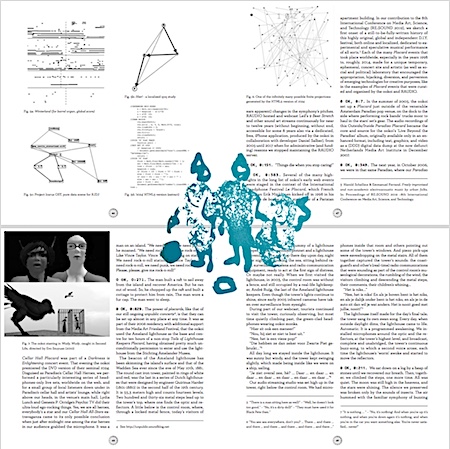
It is what you may find expressed in the aphorisms scattered along the text, like in 0 OK, 0:1013: « There may not always be a next year, but there'll always be a next number », in rhetorical questions like (0 OK, 0:211) « Will we keep our feet dry? », and the digging of canals on Mars, « someday maybe » (0 OK, 0:199).

The paragraphs in 'The inscrutable genius of the ookoi' are an onset to a 'Future of Popp', centered around that notion of anger, that will find a more elaborate form in works to come, next year, as the ookoi's mirrors pop, redefining is as qoq, music played through the looking glass, finding other expressions, newer expressions, future expressions.
Pop and qoq, they both palindrome. They read forwards the same as they backwards do, qoq and pop endlessly repeat. It's the power of beat.
Let's make it eagerly, furiously, an angry one.
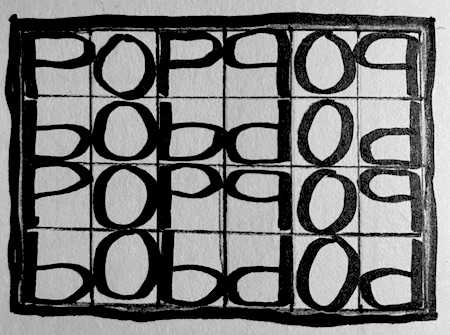
Ni venkos.
on a hot summer's day
—September 6th, a Wednesday—as part of a wondrous seven day residency at the WORM Studio (an Ali Baba's cave crammed with vintage synthesisers, bass guitars, and other things) in Rotterdam, Har$ and FPCM were joined by their fellow ex-Young Lion Tim Benjamin for an unPublic performance. Unplanned & unprepared it bloomed unrelentingly into a mix of manifest and memoir (the link to the album is in the comments), forged in musical phrases and expressed in these Dutch words brought by FPCM:
"Het zit zo, een overvloed aan klanken, in de juiste Foute Stand.
Laten we naar de melodieën wijzen!
Onhoorbaar, onluisterbaar, met al die knoppen om te danken.
Ik doe mee.
Geen zorgen, geen gedoe.
Ik zing over strijd, vol vuur, voor muntjes en een avondmaal.
Geen grenzen, geen beperkingen, geen belemmeringen!
Een avontuur."
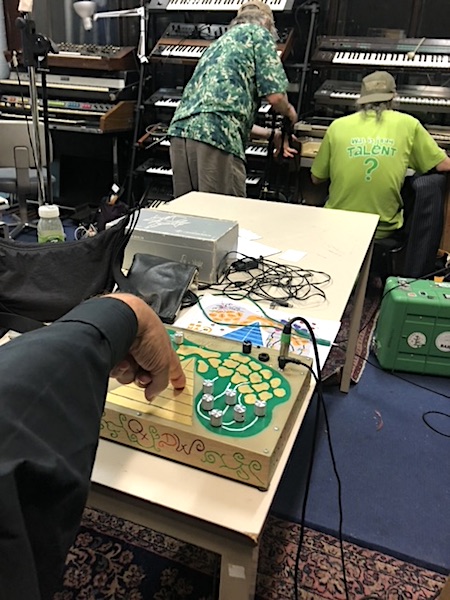
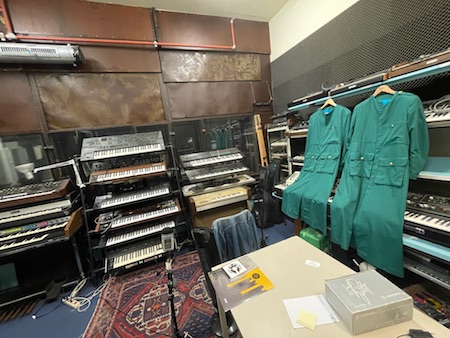
‼️ To-do as of 2024: four parallel public plays of '1024' ‼️
Every now and then I launch a four-channel play of '1024' (that is, I launch four plays of 1024 in parallel) and each time again I say to myself that we really need to try and present the piece somewhere, some places out there. It should play from the four corners of an (approximately) square and smallish white room, at a sufficient, but not too loud sound volume. That can be as a concert: when all four random walks have reached their '1024', the concert is over. It can be short, can be long. We could also let it run on. Then it would be a 'quadro-stereophonic installation', a repeating four-part random walk. When one of the walks reaches its '1024', let it rest for 1024 seconds, that is seventeen minutes and four seconds, and then start all over again.
The set-up could then look something like in the following drafts. In the first one, the '1024' projection is moreover connect to a screening of 'l'Écoute' in a second room. Looplay [sic] the video on four screens, each one linked to a sound projection in the other room, in the sense that in case one of the 1024 projections comes to its halt, the corresponding video projection in the other room will freeze.
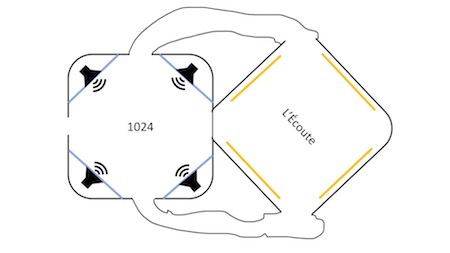
The second one is even better: it is more 'hermetic', as is clear from the scheme. The performance space can only be entered and left again via a staircase leading up from a space / floor below.
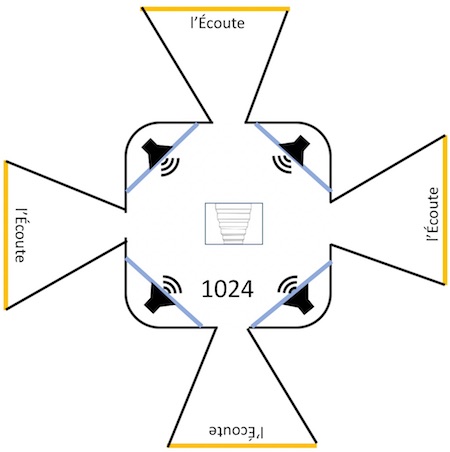
In extremis, this set-up might comes without the staircase. The installation / performance then is inaccessible from the outside. Modulo electrical & maintenance of the equipment, it may run with no eyes to see, no ears to hear, just by, in and for itself, without beginning, without end. For years and years and years.
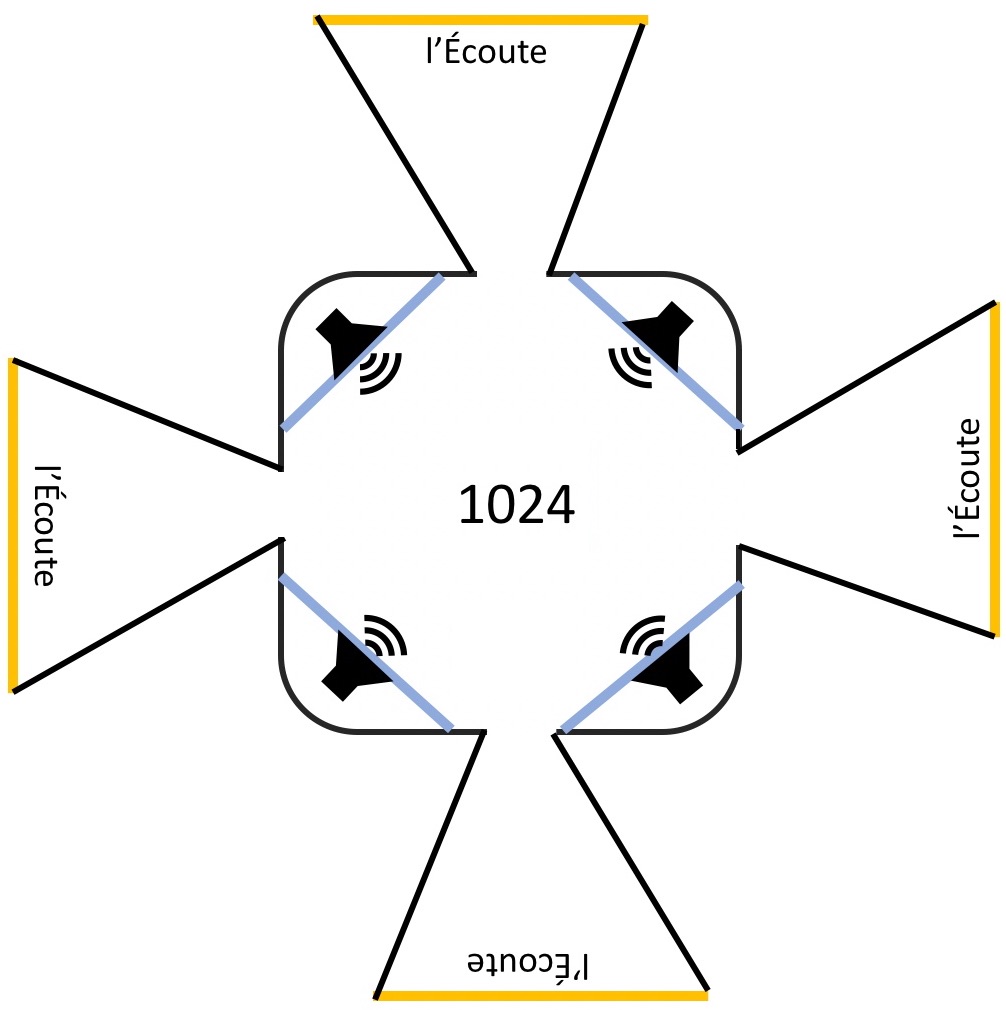
I wondered how long on the average a full four part projection of '1024' would last. Answering that question involves a little bit of probabilistic calculation, that you may want to skip, but I'll write it down anyway 🤓... The numbers that are being played in a '1024' sound-projection are picked (pseudo-)randomly by a (java)script, according to an approximately uniform distribution; hence it is like throwing a faire dice with 1024 sides. The play of a channel comes to a grinding halt the first time the script 'hits' number 1024 , and at each turn, at each cast of the dice, the probability that that happens is 1/1024. Each 'turn of the play' is, in probability terms, a Bernoulli experiment, with the probability p of 'success' equal to 1/1024. The probability that the first 'success' (a halt) occurs at the n-th turn of the play then is (1/1024) × (1023/1024)n-1. These are the possible values of a geometric probability distribution, whose expected value is 1/(1/1024)= 1024. With each turn of the play lasting 7 seconds, this means that a single projection of 1024 will on the average come to its end at the 1024th turn, that is, after 1024 x 7 seconds, i.e. in just a little less than 2 hours.
But will that also be the average duration of four simultaneous plays of '1024'? That actually is not so, and here is the why: the question we need to answer is, given four simultaneous Bernoulli experiments, each with the same probability p of 'success', what is the probability that at the n-th turn of the parallel play all four have had their 'first success' (i.e. in case of '1024', all four plays have come to a halt)?
Now that can be the case because of a different number of reasons, each of which will occur with a given (different) probability:
- all four come to a halt at play n
- three come to a halt at play n, but one other already came to a halt before the n-th play
- two come to a halt at play n, but two others already came to a halt before the n-th play
- one comes to a halt at play n, but three others already came to a halt before the n-th play
The probability we are looking for then is the sum of the probabilities of each of these four possible states occuring.
This reasoning of course generalises to whatever number of simultaneous plays, say k, each with whatever (but same) probability for coming to a halt, say p, for which we then, using the binomial theorem and a bit of algebra, can write up the probability B[k,p](n) of coming to a full stop at the n-turn of the play in the formula:

We now can calculate the expected value E[B[k,p](n)] as:

For the four parallel '1024' plays that average duration turns out to be 7 × 2132.8 seconds, that is about 4 hours and 8 minutes. The average duration appears to be more than twice that of a single play. 💪
...
synchronise across browser windows?
On my laptop a four-part play of '1024' starts by me launching the script in four different browser windows. The four parts do not start at the precise same moment, as I have to hit the four start-buttons one after the other. Curiously, I regularly notice that the four loops, each of which has a length of precisely seven seconds, that started at different random moments, at some point during a random fall in prefect sync. They loops synchronise: all four start at the same moment (see the screenshots below, the first one of which shows the start of a cycle of 3 plays that 'fell in sync',and the second the start of a cycle of 4 plays). Same sort of thing that happens with sets of clicking metronomes, but it is sort of weird to see this happen to scripted oscillation on a laptop. Maybe it's illusory, and just due to small discrepancies in file length, as also I see them sometimes drift apart again?
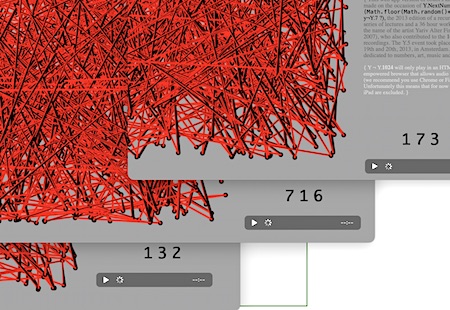
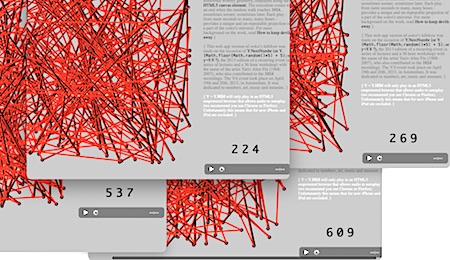
art
Start reading the b.ookoi at any page in any one of its volumes.
Then continue in whatever way and in whatever direction.
The bulk of the book's writing will be in english. That is the language in which we have been reporting on our doings at least since fpcm one spring day came over from Amsterdam, to join me in my chasing sounds on the Dutch wadden island Ameland.
That was a little over 18 years ago.
...
up - time

In the course of our living days the experience of time—'time as we feel it', we may call it our up-time—gradually but dramatically changes. When we were k, as kids, most days and weeks felt endless. They seemed to last forever. On the rear side of life's mirror, the one that we now dwell in as inverse kids (as k-1), years sadly feel as if a malicious genie has them last like once did our months and did our weeks, on that other side...
There is sort of an inversion involved here, a 1 over L that parallels k's transformation into a k-1. If the 1 is a clock time unit, a year, say, then L denotes one's age measured in those clock years. For a one year old k, that makes a one over one: a year is all of a lifetime; it lasts forever. On the backside of sixty however, there where now the ookoi roam, the year's fraction's starts pushing a mere percent of the lifetime L. And somehow our experience of time, e(t), is (or rather feels) proportional to this fraction:
e(t) ∼ γ(t) × 1/L.
It's what makes the felt passing of time speed up relentlessly when L increases, with evermore year beads strung unto its thread. That's what makes a year remembered from the k-days feel like it lasted at least as long as ten of the ones us k-1's are living now.
mean - time
It also explains why it feels as if we just recently began thinking and talking about b.ookoi, thé book that tells it all and we will write; whereas checking times and dates reveals that mention of the book goes back as far at least as early 2015, which was when fpcm made this brilliant brief vimeo announcement.
See? Feels like only yesterday.
To receive updates on the ookoi's b.ookoi's progress and all related events and activities, follow Stduio on Bandcamp!
The b.ookoi are coming!
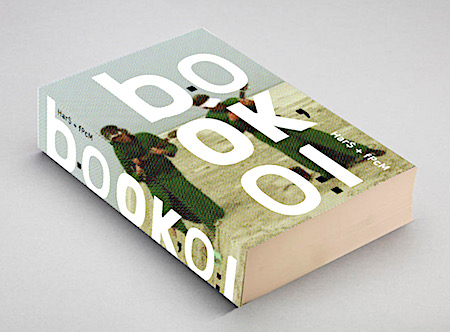
notes __ ::
(*) In: Ernst van Alphen. Aandacht schenken. De Witte Raaf, nr. 225, September/Oktober 2023, p. 4-6. [
^ ]
(**) Bart Verschaffel. First Ideas on Art. Being Moved and Criticism. In: What Artistry Can Do: Essays on Art and Beauty. Edinburgh University Press (2022). [
^ ]
(***) I guess you will have recognized the 'easy score' wink here, détournement of the lyrics to Mick Jagger & Keith Richards' ballad 'Angie' [
^ ]
Read about the ookoi elsewhere:
ANNUAL, 1, december 2023 (Korm Plastics) - Green-tainted hyperbole, quailish quirks and summer-flies. The inscrutable genius of the ookoi.
eContact! 21.2, july 2023 - Towards an Unhearable Music. Conceptualism in the ookoi's art.
Gonzo #88, september/october 2008 - Zelfcomponerende Klankstukken
Read about the ookoi and Raudio and Stduio on the SoundBlog:
(2024, december 24) - The « ookoide » (Awesome Foursomes (xxii) - No. 131)
(2024, september 10) - Home is my Rome (Awesome Foursomes (xix, xxi) - No. 506, 507)
(2024, june 17) - Long live ookoi! (Leve ookoi!): a b.ookoipera / een tehoorspel
(2024, march 04+) - The « ot-o ki do ki » (Awesome Foursomes (xviii) - No. 624)
(2023, december 31) - d.ookoi writes b.ookoi (ii) - A Year in the Rear (2023)
(2023, december 16+) - Awesome Foursomes (xi) - No. 178
(2023, december 16+) - Awesome Foursomes (x) - No. 789
(2023, december 16+) - Awesome Foursomes (ix) - No. 329
(2023, august 20) - Three days of residency at Les Ateliers Claus, Brussels
(2022, april 25) - Awesome Foursomes (viii) - No. 664
(2022, march 31) - Awesome Foursomes (vii) - No. 138
(2022, february 20) - Awesome Foursomes (vi) - No. 419
(2021, november 01) - Awesome Foursomes (v) - No. 954
(2021, august 20) - Awesome Foursomes (iv) - No. 793
(2021, july 18) - Awesome Foursomes (iii) - No. 562
(2021, july 09) - Awesome Foursomes (ii)- No. 284
(2021, june 21) - Awesome Foursomes (i) - No. 019
(2021, may 31) - d.ookoi writes b.ookoi (i)
(2020, january 26) - STDUIO Arti: aLife @Hal-fIve
(2020, january 25) - STDUIO Arti: The LⒶst Weekend
(2019, march 03) - ookoi 2.0: the remake of a spect[r]al b[r]and
(2017, april 12) - 1024
(2015, march 07) - The men once in green are now writing a book!
(2014, may 09) - You are NOT Hier!
(2013, july 03) - How to keep devils away
(2013, may 06) - Next Numbr!
(2012, june 24) - Ninja Fruit Plus Instruments
(2012, may 06) - Y.3 = Yltra !
(2012, may 06) - Our final gig / Ons laatste optreden
(2010, may 23) - 'Raise the trumpet, sound the drum'
(2010, april 02) - [Second Life and WudyWudy]
(2010, january 05) - ookoi: onderood
(2009, november 17) - Soli Deo Gloria !
(2009, october 10) - Project Icarus OST
(2009, august 24) - ookoi ShakeNRoll
(2009, july 18) - Pure . Reactive . Music . Hack Day
(2009, april 07) - "Blood and Bottom" (Raudi0GaGa)
(2009, february 21) - Insular arithmetic (ookoi toont)
(2009, january 31) - A glimpse of Heesbeen
(2009, january 15) - Rien à voir
(2008, october 02) - The right to be slow
(2008, june 06) - Raudio Graffiti: almost live !
(2008, february 24) - The Great Washing
(2007, december 04) - I'm an island
(2007, november 20) - Live Beyond the Paradiso, Amsterdam
(2007, september 04) - leve ookoi! (3)
(2007, august 22) - leve ookoi! (2)
(2007, august 12) - leve ookoi! (1)
(2007, april 12) - Back to Berlin [Raudio 11/15]
(2007, march 24) - Vicky, Killers and Avatars
(2007, february 15) - Every presentation is a premiere
(2007, january 25) - 1024 Waarden, by ookoi
(2007, january 19) - Preparations for a Second Life
(2006, november 05) - Cellarlar Heroes
(2006, october 20) - Funky shit
(2006, august 14) - placard : la générale
(2006, july 07) - de-'tails of lite house keeping'
(2006, may 06) - jam karet?
(2006, april 04) - 100+ new (r)audio philes ... [3] [Raudio 07]
(2006, march 20) - raudio @cosman's
(2006, march 12) - 100+ new (r)audio philes ... [2] [Raudio 07]
(2006, march 03) - 100+ new (r)audio philes ... [1] [Raudio 07]
(2005, october 12) - Raudio #06 [Raudio 06]
(2005, september 25) - 0 OK, 0:1, life on ze road
(2005, july 31) - Outside - Inside Paradiso
(2005, june 18) - Sand-Y da-Y #5-7 [Raudio 05]
(2005, june 05) - Sand-Y :: da-Y #04 - da birds
(2005, may 26-24) - Sand-Y :: da-Y #03, #02, #01 - Crew cut ; "The truth is out here" ; ::
(2005, may 14) - 9 Beet Stretch [Raudio Special]
(2005, march 31) - Raudio #04 :: "GespRek 1982-2005" [Raudio 04]
(2005, february 10) - raudio #3 (drie/three) [Raudio 03]
(2004, december 08) - pure sound [Raudio 02]
(2004, november 24) - other, and good news! [Raudio 01]
(2004, october 10) - raudio launched
(2004, september 24) - made in ameland
(2004, june 09) - boyzz buzz # listen!global corpus
(2004, may 20-31) - >∞-îl_o_tré
Read some of the ookoi's papers in pdf:
(2014) - Localized Sounds, Sounding Locations.
Presented at the International Symposium "Locative Media and Sound Art", Kortrijk (be)
(2007) - ookoi - Uptime Publishing Demonstration. (With Jay Needham.)
ookoi - The works:
(2015—now) :: writing b.ookoi: pick a number!
(2017) Weekly, 10'24" :: ookoi dooki podcast
(2014) HIER - iPhone app, 4 track album of localized Future Popp
(2013) Y ¬ Y.1024 (HTML5 web app)
(2013) Wandelzand - iPhone app, soundwalk for the Dutch isle of Ameland
(2012) Palm Top Theatre V2
(2010) WudyWudy, machina movie, filmed in Second Life by Evo Szuyuan (trailer)
(2009) ookoi_@_E@rport, Amsterdam - channel 19 of the RAUDIO IIIII streaming audio art iThing app
(2009) ShakeNRoll, Project Icarus OST - scenes for the RJDJ reactive music iPhone platform
(2009) iRingg®, iPhone ringtones
(2009) 2525 (video)
(2008) L'Ecoute - public space screen video
(2008) Jam Karet I & Jam Karet IV - pocket movies
(2007) Live beyond the Paradiso (USB-stick data-dump)
(2007) Leve ookoi! - channel 16 of the RAUDIO IIIII streaming audio art iThing app
(2007) 1024 (DVD)
(2007) 1024 Waarden - flash animation
(2006) "Roam Stroam" - channel 12 of the RAUDIO IIIII streaming audio art iThing app
(2006) Tijdrekken - flash animation
(2005) Sand-Y (Zandoog) - channel 7 of the RAUDIO IIIII streaming audio art iThing app
(2004) Muziektafel-Tafelmuziek (CD)
...
(1980) Signs and Symptoms
Read about ULTRA on the SoundBlog:
(2012, june 24) - A Night at the Museum [ One big sweep, from ULTRA-modern to post-experimental (iv) ]
(2012, may 06) - Y.3 = YltrA! [ One big sweep, from ULTRA-modern to post-experimental (iii) ]
(2012, may 03) - One big sweep, from ULTRA-modern to post-experimental (ii)
(2012, april 02) - One big sweep, from ULTRA-modern to post-experimental (i)
(2011, december 24) - Touching base
Read about ULTRA in Gonzo (Circus) [Dutch]:
Gonzo #108, maart/april 2012 - Ultra
An English translation of this Gonzo-essay is available on Medium:
(2023, december 30) ULTRA, in Times of Panic.
tags: ookoi, b.ookoi, ULTRA
# .538.
